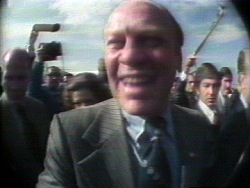
CHANNEL ZERO
CHANNEL ZERO
70 North 6th Street, Williamsburg, Brooklyn
CHANNEL ZERO
70 North 6th Street, Williamsburg, Brooklyn
CHANNEL ZERO
70 North 6th Street, Williamsburg, Brooklyn
Works
In this narrative performance for video, Burden tells the story of his relationship with a truck named "Big Job." To relate his autobiographical monologue, he sits deadpan before the camera with moving images of the truck behind him. Writes Burden, "During a six-month period, while the artist...
A family is observed watching television. The viewer becomes the object of the family's gaze, as much as the family is the object of the viewer's gaze. Writes Roswitha Mueller, "The Electronic and the Real gazes cross without interacting." Facing a Family was originally broadcast on Austrian Network Television.
The four-part series Gerald Ford's America scrutinizes the "first one hundred days" of the Ford presidency. In WIN (the title refers to the slogan "Whip Inflation Now"), the TVTV crew follows Ford on a goodwill tour of his old constituency in Ann Arbor, Michigan. Having promised to end the...
Media Burn
Ant Farm: Chip Lord, Doug Michels, Curtis Schrier, Uncle Buddie
1975, 23:02 min, color, sound
Media Burn integrates performance, spectacle and media critique, as Ant Farm stages an explosive collision of two of America's most potent cultural symbols: the automobile and television. On July 4, 1975, at San Francisco's Cow Palace, Ant Farm presented what they termed the "ultimate media event." In this alternative Bicentennial celebration, a "Phantom Dream Car"—a reconstructed 1959 El Dorado Cadillac convertible—was driven through a wall of burning TV sets.
In Shamberg's Media Primer, rhetoric and gestures are skewered as he examines the political structure of alternative media.




